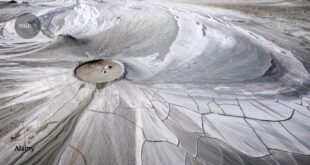- Recent satellite images have Captured Twin Cyclones in the Indian Ocean region, one in the northern hemisphere and one in the southern hemisphere, named cyclone Asani and cyclone Karim respectively.
- Karim is classified as a category II hurricane, with a wind speed of 112 kilometers per hour (kmph).
- Asani remains a Severe Cyclonic Storm over the Bay of Bengal, with wind speeds of 100-110 kmph gusting to 120 kmph.
- Both were formed in the Indian Ocean region.
- Both cyclones originated in the same longitude and now drifting apart.
- Cyclone Karim has created a path in the open seas west of Australia.
- The name Karim was given by the South African country Seychelles. The name Cyclone Asani was suggested by Sri Lanka.
Twin Cyclones
- The interplay of the wind and the monsoon system combined with the Earth system produces these synchronous cyclones.
- The twin tropical cyclones are caused by what are called equatorial Rossby waves.
- Rossby waves are huge waves in the ocean with wavelengths of around 4,000–5,000 kilometres.
- Rossby waves are named for famous meteorologist Carl-GustafRossby who was the first to explain that these waves arose due to the rotation of the Earth.
- This system has a vortex in the northern hemisphere and another in the southern hemisphere, and each of these is a mirror image of the other.
- The vortex in the north spins counterclockwise and has a positive spin, while the one in the southern hemisphere spins in the clockwise direction and therefore has a negative spin.
- Both have a positive value of the vorticity which is a measure of the rotation.
- Very often twin cyclones are formed from these Rossby waves.
Cyclones
- When the vorticity is positive in both Northern and Southern hemispheres, as is the case with Rossby waves, the air in the boundary layer, which is moist, is lifted slightly.
- That is enough to set off a feedback process.
- When the air is lifted slightly, the water vapour condenses to make clouds. As it condenses, it lets out the latent heat of evaporation.
- The atmosphere warms, this parcel of air rises, and positive feedback is set off by this process. The warmer parcel of air can rise further because it is lighter than the surrounding air, and it can form deeper clouds. Meanwhile, moisture comes in from both sides. This leads to the formation of a cyclone if certain conditions are present.
- The ocean’s surface temperature has to be 27 degrees or warmer; the wind shear in the atmosphere must not be too high.
- For example, if you have westerly winds at the lower level and easterly winds at the upper level, if the difference between them is too high, cyclones will not form.
- But if the difference is modest, cyclones will still form.
- There will be a big, tall vortex with all sorts of clouds inside. Once they are stronger, they will spin faster and faster and organise themselves into the big storms.
SOURCE: THE HINDU,THE ECONOMIC TIMES,MINT
 Chinmaya IAS Academy – Current Affairs Chinmaya IAS Academy – Current Affairs
Chinmaya IAS Academy – Current Affairs Chinmaya IAS Academy – Current Affairs



